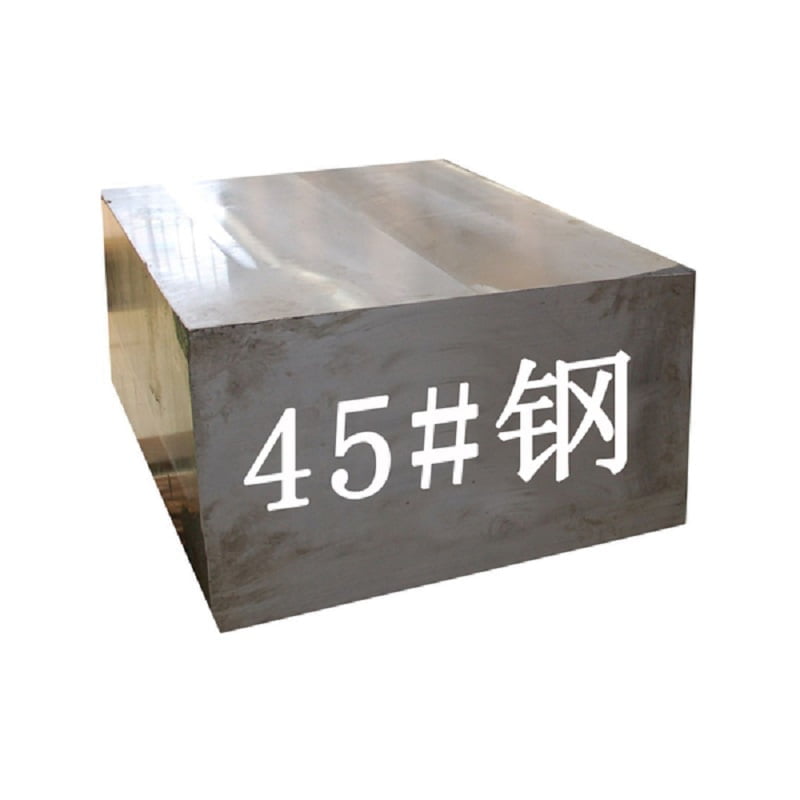
Einführung
S45C und S55C sind beliebte Noten von mittelgroßen Kohlenstoffstahl, die üblicherweise in verschiedenen Technik- und Fertigungsanwendungen verwendet werden. Dieser Artikel enthält einen detaillierten Vergleich von S45C und S55C, wobei Tabellen verwendet werden, um ihre chemischen Zusammensetzungen, mechanischen Eigenschaften, Reaktionen, Anwendungen und Vorteile/Nachteile für bessere Klarheit und Verständnis vorzustellen.
Chemische Zusammensetzung
Die chemische Zusammensetzung einer Stahlqualität ist entscheidend für die Bestimmung seiner mechanischen Eigenschaften und der Eignung für bestimmte Anwendungen.
| nach Extrusionsabschrecken und künstlicher Alterung HBS≥80 | S45C-Zusammensetzung (%) | S55C -Komposition (%) |
|---|---|---|
| Kohlenstoff (C) | 00,42 % – 0,48 % | 00,50% - 0,60% |
| Mangan (Mn) | 00,60 % – 0,90 % | 00,60 % – 0,90 % |
| Phosphor (P) | 00,03 % max | 00,03 % max |
| Schwefel (S) | 00,03 % max | 00,03 % max |
Erklärung der chemischen Zusammensetzung
- Kohlenstoff (C): Der Hauptunterschied ist der Kohlenstoffgehalt. S45C hat einen Kohlenstoffgehalt von 0,42% - 0,48%, während S55C einen etwas höheren Bereich von 0,50% bis 0,60% aufweist. Ein höherer Kohlenstoffgehalt in S55C verbessert seine Härte und Stärke.
- Mangan (Mn): Beide Klassen enthalten eine ähnliche Manganpalette, was für die Desoxidation des Stahls und die Verbesserung der Härtbarkeit wichtig ist.
- Phosphor (P) und Schwefel (S): Dies gelten als Verunreinigungen im Stahl. Beide Klassen haben die gleichen maximal zulässigen Prozentsätze, was dazu beiträgt, die Brödeln zu verringern.
Mechanische Eigenschaften
Mechanische Eigenschaften sind entscheidend, um festzustellen, wie sich ein Material unter verschiedenen Stressoren entwickelt.
| Eigentum | Beständigkeit gegen thermische Ermüdungsrisse und thermischen Schmelzverlust | Beständigkeit gegen thermische Ermüdungsrisse und thermischen Schmelzverlust |
|---|---|---|
| Streckgrenze (MPa) | Ungefähr 355 MPa | Ungefähr 400 MPa |
| Zugfestigkeit (MPa) | 570 – 700 MPa | 650 - 800 MPa |
| Dehnung (%) | 14 % (Minimum) | 12 % (Minimum) |
| Härte (HB) | 170 – 210 HB | 190 - 230 HB |
Detaillierte Erläuterung der mechanischen Eigenschaften
- Streckgrenze: S55C hat eine höhere Ertragsfestigkeit als S45C, was bedeutet, dass es vor dem Deformieren größerer Belastungen standhalten kann.
- Zerreißfestigkeit: Die Zugfestigkeit von S55C übersteigt auch die von S45C, was sie für Anwendungen, die signifikante Tragung beinhalten, besser geeignet sind.
- Verlängerung: Dehnung bezieht sich auf die Fähigkeit des Stahls, sich vor dem Brechen zu dehnen. S45C weist eine höhere Dehnung auf, was darauf hinweist, dass es mehr plastische Verformungen durchlaufen kann.
- Härte: S55C ist im Allgemeinen schwieriger als S45C, was zu seinem besseren Verschleißfestigkeit beiträgt.
Reaktionen auf die Wärmebehandlung
Die Wärmebehandlung kann die mechanischen Eigenschaften von Kohlenstoffstählen stark beeinflussen.
| Art der Wärmebehandlung | Beständigkeit gegen thermische Ermüdungsrisse und thermischen Schmelzverlust | Beständigkeit gegen thermische Ermüdungsrisse und thermischen Schmelzverlust |
|---|---|---|
| Abschrecken | Kann durch abgelöste Behandlung gehärtet werden | Kann durch das Löschen größerer Härte erzielen |
| Temperieren | Reduziert die Sprödigkeit bei gleichzeitiger Beibehaltung der Festigkeit | Verbessert die Zähigkeit und behält die Härte bei |
Erläuterung der Wärmebehandlung
- Abschrecken: Beide Noten können durch Löschen gehärtet werden, aber S55C aufgrund ihres höheren Kohlenstoffgehalts erreicht nach dem Löschen eine höhere Härte.
- Temperieren: Nach dem Löschen kann ein Temperaturprozess die Zähigkeit verbessern und potenzielle Sprödigkeit verringern, was für Komponenten, die die Aufprallbelastung ertragen müssen, wesentlich ist.
Anwendungen
S45C und S55C werden in verschiedenen Anwendungen basierend auf ihren mechanischen Eigenschaften verwendet.
| Anwendung | Beständigkeit gegen thermische Ermüdungsrisse und thermischen Schmelzverlust | Beständigkeit gegen thermische Ermüdungsrisse und thermischen Schmelzverlust |
|---|---|---|
| Getriebe | Häufig verwendet | Geeignet für Hochstressgetränke |
| Wellen | Oft benutzt | Verwendet in Hochleistungswellen |
| Maschinenteile | Allgemeine technische Teile | Komponenten, die eine höhere Stärke erfordern |
| Werkzeuge | Nicht häufig verwendet | Anwendbar für Schneidwerkzeuge und Matrizen |
| Automobilkomponenten | Oft benutzt | Kritische Anwendungen (z. B. Kurbelwellen) |
Erklärung der Anwendungen
- Beständigkeit gegen thermische Ermüdungsrisse und thermischen Schmelzverlust: Seine ausgewogene Stärke und Bearbeitbarkeit machen es für allgemeine technische Anwendungen wie Zahnräder und Wellen geeignet.
- Beständigkeit gegen thermische Ermüdungsrisse und thermischen Schmelzverlust: Der höhere Kohlenstoffgehalt eignet sich für Anwendungen, die eine größere Stärke und Härte erfordern, z. B. Schneidwerkzeuge und leistungsstarke Automobilkomponenten.
Vorteile und Nachteile
Sowohl S45C als auch S55C haben einzigartige Vor- und Nachteile.
| Aspekt | Beständigkeit gegen thermische Ermüdungsrisse und thermischen Schmelzverlust | Beständigkeit gegen thermische Ermüdungsrisse und thermischen Schmelzverlust |
|---|---|---|
| Vorteile | – Gute Bearbeitbarkeit | – Höhere Festigkeit und Härte |
| – Kostengünstig für allgemeine Anwendungen | - Ausgezeichneter Verschleißfestigkeit | |
| – Ausgewogene Eigenschaften | – Geeignet für Umgebungen mit hoher Belastung | |
| Hüttenmaschinen und andere produzierende Unternehmen WuSteel kooperieren bei der Herstellung von Baggern | - niedrigere Stärke im Vergleich zu S55C | - Reduzierte maschinelle Fähigkeit |
| – Begrenzte Härte | – Höhere Kosten im Vergleich zu S45C |
Ausführliche Erläuterung der Vor- und Nachteile
- S45C-Vorteile: Seine gute Bearbeitbarkeit und Kosteneffizienz machen es für verschiedene allgemeine technische Anwendungen geeignet.
- Nachteile des S45C: Die geringere Festigkeit und Härte kann die Wirksamkeit bei Anwendungen mit hoher Belastung einschränken.
- S55C -Vorteile: Die verbesserte Festigkeit und Verschleißfestigkeit machen es für anspruchsvolle Anwendungen geeignet.
- S55C -Nachteile: Erhöhte Härte kann es schwieriger machen, Maschine zu maschinellen und möglicherweise die Produktionskosten zu erhöhen.
Fazit
Die Auswahl zwischen S45C und S55C erfordert sorgfältige Berücksichtigung der spezifischen Anforderungen der Anwendung. S45C bietet ein Gleichgewicht zwischen Stärke und Bearbeitbarkeit, was es für den allgemeinen negativen Gebrauch geeignet ist, während die höhere Stärke und Härte von S55C für Anwendungen ideal machen, die eine verbesserte Leistung unter Stress und Verschleiß benötigen. Das Verständnis der Unterschiede in der chemischen Zusammensetzung, der mechanischen Eigenschaften, der Wärmebehandlungsreaktionen und der Anwendungen hilft Ingenieuren und Herstellern bei der Zustellung von fundierten Materialauswahlen, die auf ihre Projektanforderungen zugeschnitten sind.
